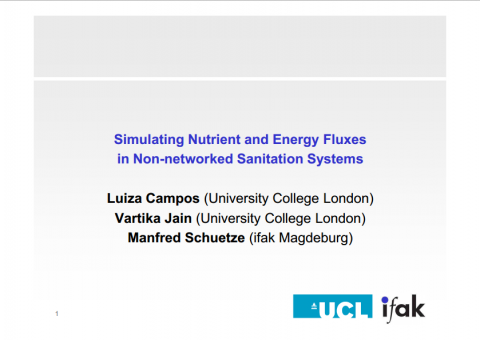Modelling the next generation of sanitation systems - Various documents on results from research grant
Campos, L. C. (2013)

Published in: 2013
Publisher:
University College London, UK
Author:
Campos, L. C.
Uploaded by:
SuSanA secretariat
Partner profile:
common upload
5793 Views
138 Downloads
Location of library entry
Content - Summary
This library entry contains background documents for a grant that Luiza Cintra Campos is leading and which is funded by the Bill and Melinda Gates Foundation.
Further information and a discussion is available on the SuSanA discussion Forum, see link below.
Short description of the project:
The project develops a simulator for sanitation systems. The novelty of this project lies in the adaptation of an existing resource-flux simulation methodology used on networked systems to calculate nutrient and energy fluxes specifically for on-site sanitation systems. The simulation methodology has been already applied successfully by ifak in several networked sanitation contexts in developing countries. However, the concept is currently being extended to cater for non-networked sanitation systems. The model outputs are the main fluxes of energy and nutrients and, thus, their available amount for recovery, volume/quality of treated waste for reuse; and monetary value of the waste reuse. Demonstration of systems which have increasing commercial viability due to waste reuse/nutrients recovery can be used to explore business opportunities for sanitation. The flexibility of the simulator also allows to include in the future modules for sanitation technologies developed in the future. Once further developed, the model will have the potential to aid city-managers to evaluate alternative sanitation technologies and to select the most sustainable and cost-effective solution. Significant cost-savings and improved utilization of resource streams, thus increasing revenue, are expected by application of this simulator.
Goal(s):
The goal of this project is to develop an easy-to-apply simulation tool set up to enable local city managers to assess the implications of adopting alternative sanitation strategies at scale.
Objectives:
The main aim of Phase-I is to develop a simulation tool to model flux of residual wastes from streams in the sanitation service delivery chain, focusing on nutrient and energy fluxes.
Research or implementation partners:
UCL is working in collaboration with ifak which is a non-profit institute for applied research at Otto-von-Guericke University in Magdeburg/Germany that develops simulation models for water and wastewater applications.
Authors:
Campos, L., Jain, V., Schuetze, M.
Start and end date: November 2011 - October 2013
+++++++++++
Documents available for download below:
1 - Modelling the next generation of sanitation systems (2 page description, 2012)
2 - Simulating nutrient and energy fluxes in non-networked sanitation systems (paper at FMS2 conference in Durban, South Africa, Oct. 2012)
3 - Simulating nutrient and energy fluxes in non-networked sanitation systems (presentation at FSM2 Conference in Durban, South Africa, Oct. 2012)
4 - Short presentation at SuSanA/SEI webinar number 5 (21 Jan. 2014)
Bibliographic information
Campos, L. C. (2013). Modelling the next generation of sanitation systems - Various documents on results from research grant. University College London, UK
Filter tags
English Europe & Central Asia Fundamental research and engineering Sub-Saharan Africa














